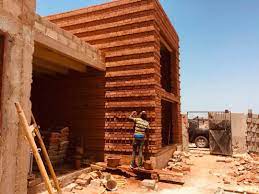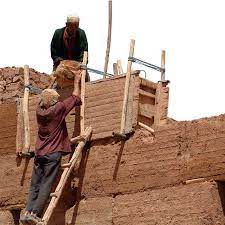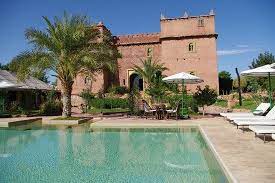 Traditional construction technique with modern applications.
Traditional construction technique with modern applications.
Marrakech is home to a rich architectural heritage, with numerous buildings reflecting the diverse cultural influences of the country and centuries of history. One of the most fascinating and sustainable techniques used in Moroccan architecture is rammed earth construction, a traditional construction method that has been used for centuries and continues to be employed today. In this article, we will explore the history and techniques of rammed earth construction in Morocco, as well as its modern applications and how ELYSEE-BAT has embraced this rich tradition. We will also discuss the incorporation of biomaterials in rammed earth construction.
What is Rammed Earth Construction?
Rammed earth construction is a traditional building technique that involves compacting layers of soil and stabilizing them with a mixture of straw and water. The soil used in rammed earth construction is typically composed of clay, sand, and gravel, and may also include other organic materials such as cow dung or straw. The soil is placed into a wooden form or mold and then compacted using a rammer or tamper. The stabilized mixture is then allowed to dry and harden, forming a solid and durable wall or structure.
Rammed earth construction has been used for centuries in Morocco and other regions with similar climates, where it offers excellent thermal insulation and protection against the harsh desert environment. The technique is particularly well-suited to the Moroccan climate, where temperatures can exceed 40 degrees Celsius in summer and drop below freezing in winter. The thick walls of rammed earth buildings help regulate the interior temperature, keeping it cool in summer and warm in winter.
History of Rammed Earth Construction in Morocco
The origins of rammed earth construction in Morocco are not clear, but it is believed to have been used in the region for centuries. Rammed earth constructions are particularly common in the southern regions of Morocco, including the Atlas Mountains and the Sahara Desert. These areas are characterized by a harsh desert climate, with hot summers and cold winters, and rammed earth construction provides an effective means of coping with these extreme conditions.
Rammed earth construction has played a significant role in Moroccan architecture, especially in rural areas where it is still used today. In addition to its thermal properties, rammed earth is an economical and sustainable building material, utilizing locally available materials.
Modern Applications of Rammed Earth Construction in Morocco
While rammed earth construction is primarily associated with traditional and rural architecture, it has also found modern applications in Morocco. ELYSEE-BAT, for example, has extensive experience in rammed earth construction and has applied this traditional construction technique to a range of modern projects.
One of the advantages of rammed earth construction is its versatility, allowing it to adapt to a range of architectural styles and design requirements. ELYSEE-BAT has used rammed earth construction in a variety of projects, including residential and commercial buildings, hotels, and public spaces. The company has also integrated modern construction techniques and materials into its rammed earth projects, such as reinforced concrete, to ensure the durability and longevity of the structures.
Incorporating bio materials in rammed earth construction
In recent years, there has been a growing interest in incorporating bio materials in rammed earth construction as a means to enhance its sustainability and environmental friendliness. Bio materials are natural materials derived from plants or animals that can be used as additives or reinforcements in rammed earth construction.
One commonly used bio material in rammed earth construction is straw, which is added to the earth mixture to increase its tensile strength and reduce cracking. Other bio materials that can be used in rammed earth construction include wood fibers and bamboo.
Rammed earth construction offers numerous health benefits due to its natural, durable, and breathable properties. One of the main advantages of rammed earth construction is its ability to naturally regulate indoor temperature without the need for air conditioning or heating. The thick walls of rammed earth buildings provide excellent thermal mass, absorbing heat during the day and releasing it at night, keeping the interior cool during hot weather and warm during cold weather. This can significantly reduce energy consumption and associated costs, while minimizing health risks associated with air conditioning, such as poor air quality, noise pollution, and the spread of airborne diseases. Additionally, rammed earth construction promotes a healthier living environment by reducing the need for synthetic materials and chemicals, which can have adverse effects on respiratory health and overall well-being.
Here are some advantages of using bio materials in rammed earth construction:
- Durability: Bio materials such as straw and wood are renewable resources that can be cultivated and harvested without depleting the earth’s natural resources. This makes them a sustainable choice for construction materials, reducing the impact of construction on the environment.
- Energy efficiency: Bio materials have excellent insulation properties, which can help naturally regulate indoor temperatures, thus reducing the need for artificial heating or cooling. This can result in reduced energy consumption and associated costs, while promoting a healthier living environment.
- Health benefits: The use of natural and non-toxic bio materials can help improve indoor air quality, thereby reducing the risk of respiratory problems and allergies. Additionally, many bio materials have antimicrobial properties, which can inhibit the growth of molds and other harmful organisms.
- Aesthetic appeal: Bio materials can add visual interest and texture to rammed earth buildings, creating a unique and natural aesthetic that is both beautiful and functional.
In conclusion, the use of bio materials in rammed earth construction can enhance sustainability, energy efficiency, health, and aesthetics, making it an excellent choice for those seeking to build environmentally friendly and durable homes or buildings.



